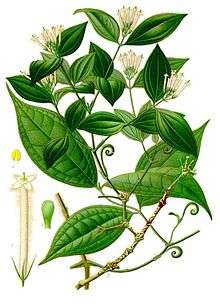Strychnos
Strychnos is a genus of flowering plants, belonging to the family Loganiaceae (sometimes Strychnaceae). The genus includes about 100 accepted species of trees and lianas, and more than 200 that are as yet unresolved.[1] The genus is widely distributed around the world's tropics and is noted for the presence of poisonous indole alkaloids in the roots, stems and leaves of various species. Among these alkaloids are the well-known and virulent poisons strychnine and curare.
| Strychnos | |
|---|---|
 | |
| Strychnos toxifera | |
| Scientific classification | |
| Kingdom: | Plantae |
| Clade: | Tracheophytes |
| Clade: | Angiosperms |
| Clade: | Eudicots |
| Clade: | Asterids |
| Order: | Gentianales |
| Family: | Loganiaceae |
| Genus: | Strychnos L. |
| Species | |
|
about 190 | |

Strychnos psilosperma foliage and fruit
Distribution
The genus has a pantropical distribution.
Taxonomy
The genus is divided into 12 sections, though it is conceded that the sections do not reflect evolution of the genus, and all sections except Spinosae are polyphyletic:[2]
- Strychnos (53 species)
- Rouhamon (21 species)
- Breviflorae (32 species)
- Penicillatae (17 species)
- Aculeatae (1 species)
- Spinosae (4 species)
- Brevitubae (18 species)
- Lanigerae (32 species
- Phaeotrichae (1 species)
- Densiflorae (8 species)
- Dolichantae (9 species)
- Schyphostrychnos (1 species)
Selected species
- Strychnos benthami
- Strychnos camptoneura Gilg & Busse
- Strychnos chromatoxylon
- Strychnos elaeocarpa
- Strychnos ignatii
- Strychnos madagascariensis
- Strychnos mellodora
- Strychnos millepunctata
- Strychnos nux-vomica
- Strychnos potatorum
- Strychnos psilosperma
- Strychnos pungens
- Strychnos spinosa
- Strychnos staudtii
- Strychnos tetragona
- Strychnos usambarensis
- The strychnine tree, Strychnos nux-vomica, native to tropical Asia, is the source of the poison strychnine.
- Strychnos tonganensis, native to Tonga, related to Strychnos spinosa.
- Strychnos ignatii ("St. Ignatius bean"), is a closely related Asian shrub/tree.
- The species Strychnos toxifera, a principal plant source of the arrow poison curare.
- Three trees from Southern Africa, commonly known as "monkey oranges", are drought-tolerant and produce popular edible fruits: the corky-barked monkey orange or suurklapper, Strychnos cocculoides, the Natal orange or green or spiny monkey orange, Strychnos spinosa, and the black or spiny-leaved monkey orange Strychnos pungens.
- The ripe seeds of Strychnos potatorum,[3][4] known as Therran or Nirmal, can be ground and used as a coagulant to purify water; or they may be rubbed against the inside walls of the earthenware water containers. Mrs Grieve's Herbal of 1931 also mentions traditional water purification uses of an Indian species called Strychnos pseudo (not a valid botanical name).[5]
- Two very well preserved fossilised corollas with stamens and styles from flowers of a plant that has been named Strychnos electri (the Latin name of amber is electrum), believed to be a vine, were discovered in amber from the Dominican Republic. The amber is from tropical tree Hymenaea protera, formerly abundant but now extinct, which formed part of the forest canopy. The age of the amber is believed to be between 15 and 45 million years, from the mid-Tertiary period. This demonstrates an early date for these plants.[6][7]
References
- The Plant List
- Aguilar, Javier Fuertes (2003). "Phylogenetic Relationships and Classification of the Sida Generic Alliance (Malvaceae) Based on nrDNA ITS Evidence". Systematic Botany. 28 (2): 352–364. JSTOR 3094004.
- Solar Disinfection Studies
- G. Annalakshmi (19 April 2005). "Solar Disinfection Studies". Deccan Herald. Archived from the original on 9 April 2007.
- Strychnos nux-vomica
- New species of ancient tropical flower found in amber from the Dominican Republic, Rachel Sullivan, ABC News Online, 16 February 2016
- George Poinar, Jr. and Lena Struwe (2016). "An asterid flower from neotropical mid-Tertiary amber". Nature Plants. doi:10.1038/nplants.2016.5. ISSN 2055-0278., Article number 16005
External links
- Babu, R.; Chaudhuri, M. (Mar 2005). "Home water treatment by direct filtration with natural coagulant" (pdf). Journal of Water and Health. 3 (1): 27–30. PMID 15952450.
This article is issued from Wikipedia. The text is licensed under Creative Commons - Attribution - Sharealike. Additional terms may apply for the media files.